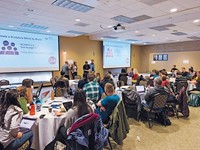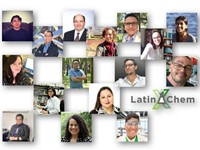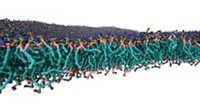Advertisement
Grab your lab coat. Let's get started
Welcome!
Welcome!
Create an account below to get 6 C&EN articles per month, receive newsletters and more - all free.
It seems this is your first time logging in online. Please enter the following information to continue.
As an ACS member you automatically get access to this site. All we need is few more details to create your reading experience.
Not you? Sign in with a different account.
Not you? Sign in with a different account.
ERROR 1
ERROR 1
ERROR 2
ERROR 2
ERROR 2
ERROR 2
ERROR 2
Password and Confirm password must match.
If you have an ACS member number, please enter it here so we can link this account to your membership. (optional)
ERROR 2
ACS values your privacy. By submitting your information, you are gaining access to C&EN and subscribing to our weekly newsletter. We use the information you provide to make your reading experience better, and we will never sell your data to third party members.
Education
Online Outreach
Chemists are taking to web tools to fulfill ‘broader impact’ requirement in NSF grants
by Carmen Drahl
November 29, 2010
| A version of this story appeared in
Volume 88, Issue 48

It was late afternoon on Oct. 12, and for Austa M. Parker and Caitlin M. Glover, time was running out. They’d just been told that they couldn’t use plastic bags of ice to preserve their water samples, meticulously collected from a beach on the Gulf of Mexico’s oil-laden Louisiana shore, during shipping. And they had a flight to catch in a few hours. If the pair didn’t find the right kind of ice pack soon, their samples might not safely make it back home, where they planned to use the specimens to study the photochemical fate of a dispersant used in this year’s Gulf oil spill cleanup efforts.
Navigating New Orleans roads by car, the two University of Colorado, Boulder, graduate students hunted for a store that carried the sealed, self-contained ice packs they needed. Along the way, they used their smartphones to chronicle their quest on the microblogging website Twitter. They’d already explored a rural grocery store close to the beach earlier in their trip. No ice packs to be found, but the market’s inventory had certainly adapted to recent circumstances. “There were tons of nitrile gloves, sponges, and oil cleaners for sale,” Parker tweeted at the time.
In the end, they found the ice packs they needed and a friendly shipping agent to send out their samples. “Love UPS ... cooler crisis averted!” Glover tweeted.
Parker and Glover weren’t using Twitter just to update their friends and their two research advisers—respectively, environmental engineering professors Karl Linden and Fernando Rosario-Ortiz. Their tweets were an integral part of what they proposed to do during their mission in the Gulf, as part of the National Science Foundation grant application that ultimately funded the fieldwork.
It’s still very rare for NSF research grant proposals to incorporate Twitter. But Twitter is just one of several Web tools that a handful of researchers are using to creatively address an important part of NSF’s evaluation process: the broader-impact criterion.
Grant proposals submitted to NSF are evaluated on their potential for impact beyond the science in addition to their intellectual merit. “People completely understand how to describe their project’s intellectual merit,” says Lisa Van Pay, a public affairs specialist in math and physical sciences at NSF. But the grasp of broader impact can be more nebulous, she says. New Web technology is valuable because it gives researchers more options to create a broader-impact strategy that suits them best, Van Pay says. The Colorado team members are among those doing research in chemistry who have found broader-impact inspiration in familiar websites.
NSF’s broader-impact criterion has several dimensions, Van Pay explains. It’s not just about disseminating research broadly, which can be done with Twitter. Broader impact is about several things, such as helping more underrepresented groups participate in science, enhancing infrastructure for research and education, and promoting teaching, training, and learning.

Twitter isn’t the only component of the broader-impact strategy for the Colorado team, whose NSF grant is one of many Gulf oil-spill-related rapid-response research awards made by the agency. “We’re also planning to develop science and engineering lessons based on what we’re doing,” Linden says.
Linden has attended NSF and American Association for the Advancement of Science-sponsored workshops designed to help researchers communicate their work to nonexperts and lay audiences. Since Parker, Glover, and their samples returned, his team has been analyzing the samples with a mass-spectrometry-based method designed to follow a dispersant’s photochemical fate. Once results come in, Linden’s team will incorporate them into course material designed to explore the pros and cons of using dispersants to aid oil spill cleanups.
Twitter is just one piece of the broader-impact package that inorganic chemist Daniel T. de Lill proposed in his successful NSF postdoctoral fellowship application, which funded his research at the University of Nevada, Reno. In the lab, he focused on making new ligands for complexing lanthanide ions, with possible applications in “green” lighting technology and biomedical imaging. But to fulfill broader outreach, he tapped his campus’ journalism department.
Together, they created a communications campaign to promote careers in chemistry among local Nevada high school students. The campaign, which is still at the pilot stage, was given the misspelled name ChemistRE because it aims to “redefine” chemistry as an engaging discovery process relevant to everyday life. Among other things, the campaign model incorporates YouTube, Twitter, Facebook, a scholarship competition, and an attention-grabbing giveaway: green-framed sunglasses with a ChemistRE logo.
Social media sites such as Facebook are an excellent way to reach high school students, as long as you do it right, says M. Todd Felts, a journalism professor at Nevada and de Lill’s collaborator. “They can spot something inauthentic a mile away,” he says. So it’s important to avoid slick-looking videos from production crews, he adds. Instead, the model Felts and de Lill devised entices students to post their own stories about how chemistry affects their lives, with help from incentives such as the scholarship competition. At last spring’s American Chemical Society national meeting in San Francisco, de Lill and Felts presented their strategy before the Division of Chemical Education and attended poster sessions to discuss the ChemistRE campaign, giving out sunglasses along the way. “Exposure at ACS brought in at least 20 friends on Facebook that I can recall—likely more,” de Lill says.
Activity on the campaign websites has stopped during the past few months because de Lill cut his fellowship short to become an assistant professor of chemistry at Florida Atlantic University. But he and Felts are preparing to submit a publication describing their model, and they plan to adapt the campaign to Florida schools.
Ming C. Hammond was inspired by the popular online classifieds site Craigslist. The University of California, Berkeley, assistant professor of chemistry spearheaded the development of YouSTEM.org, a free Web resource that premiered last month. The site contains information about free local programs in science, technology, engineering, and math (the so-called STEM disciplines) from disparate university and institute websites, putting them in one convenient, searchable spot for K–12 students, parents, and teachers. The idea is to both help underrepresented groups participate in science and enhance infrastructure for promoting science education outside the classroom.
“Different researchers looking to fulfill this broader-impact requirement have to find something they care about within this general problem about how to broaden participation in the sciences,” Hammond says. For her, what stood out was a high school summer internship in a research lab, something that helped guide her down the first steps of her career path.
Universities and colleges offering research experiences for underrepresented groups don’t always have the budget to advertise, and people in school districts where money and time are scarce don’t have the resources to comb scores of websites to find internships, Hammond says. So she and her research group joined forces with two Web developers who also had positive research internship experiences. By creating the one-stop shop that is YouSTEM, “we hope to connect the programs with more of the students they want to target,” Hammond says. She has included YouSTEM as a prominent part of her outreach strategy in an NSF Early Career Development grant application.
So far, Hammond and her research group have stayed local, making connections with Bay Area K–12 schools and universities to promote and populate the YouSTEM site. “I’ll be the first to admit I’m not social media savvy,” Hammond says. But if YouSTEM is successful in the Bay Area, she would like to share the infrastructure with others so that, like Craigslist, the service could be expanded to other areas.
It’s one thing to propose using the Web for broader-impact purposes, but once things get under way, it’s equally important to determine whether efforts are reaching the intended audience or audiences, says Roger Harris, a social media strategist with a biology background who leads the firm Harris Social Media. “Social media is not easy,” he says. It takes time to build expertise and an audience—and still more time to monitor effectiveness.
Before a project begins “there needs to be high-level thinking and strategizing about the group you want to reach and what impact you want to have,” he says. For instance, targeting scientific outreach efforts to “the general public” is an extremely broad goal that is unlikely to be successful, he adds.
NSF’s Van Pay agrees. “The biggest thing to consider is who your target audience is and whether online is a good place to reach them,” she says. Online broader-impact strategies aren’t for every chemist or every project, she points out. “Some researchers’ time might be better spent volunteering in person at events,” she adds. “We want to make sure people are communicating in a way that works with their project and that’s right for them.”
As for the Colorado team members, they are still working on finding the most efficient ways to spend their time online as their research progresses. “I don’t really know what audience I’m looking at yet,” Linden says. “For me, it’s about how I can fit Twitter into my day in a way that is meaningful.”





Join the conversation
Contact the reporter
Submit a Letter to the Editor for publication
Engage with us on Twitter